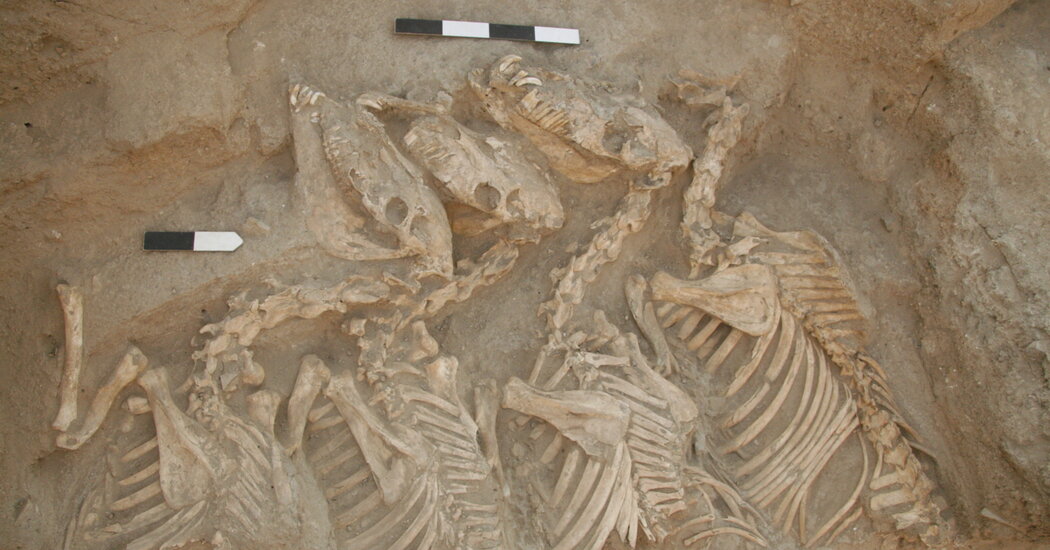A new study finds the first known instance of a human-engineered hybrid, bred from a donkey and a Syrian wild ass 4,500 years ago.
In ancient Mesopotamia 4,500 years ago, long before horses arrived in the region, another spirited member of the equine family, the kunga, took a starring role in pulling four-wheeled wagons into battle.
Archaeologists had suspected that these animals — depicted in art, their sales recorded in cuneiform writing, their bodies sometimes laid to rest in rich burial sites — were the result of some kind of crossbreeding. But proof was lacking.
On Friday, a team of researchers reported on more than a decade of research in the journal Science Advances, concluding that studies of ancient DNA showed the kunga was a cross between a female donkey (Equus Africanus asinus) and a male Syrian wild ass (Equus hemionus hemippus).
The kunga is the first known instance of a human-engineered hybrid of two species, a production far beyond the traditional processes of the domestication of animals, the researchers found.
Eva-Maria Geigl, a specialist in ancient genomes at the University of Paris, and one of the scientists who did the study, said the breeding of kungas was really “early bioengineering” that developed into a kind of ancient biotech industry.
Like mules, which are hybrids between horses and donkeys, and which were created much later, the kungas were sterile. Each new kunga was a one-off, a mating between a wild ass stallion and a donkey.
The stallions had to be captured and kept in captivity, even though they were highly aggressive, as modern records have indicated. Dr. Geigl said that the director of a zoo in Austria, where the last captive Syrian wild asses died, described them as “furious.” Archaeological records show that a breeding center in Nagar (now Tell Brak, Syria) shipped the young kungas to other cities. They were costly animals, status symbols, and were used in war and military ceremonies.
Kungas held their high status for at least 500 years, Dr. Geigl said. Horses did not appear until around 4,000 years ago to take their place in battle and ceremony, and to contribute to the creation of other hybrids. Before the current research, the oldest known hybrid was a mule from a site in Turkey dating to 3,000 years ago. Members of the same team reported on that find in 2020.
The research team had to cope with the very poor preservation of fossils from desert areas, but used a variety of techniques to examine ancient DNA. Laurent Frantz, a paleogenomics expert at Ludwig Maximilian University of Munich, who was not involved in the study, said that despite these difficulties, the “results were very convincing,” showing that people “were experimenting with hybrid equids long before the arrival of the horse.”
Fiona Marshall, an archaeologist at Washington University in St. Louis, who has researched the prehistory of donkeys and their domestication, said the study was “enormously significant” partly because it showed that the breeders had clear intentions. The early process of domestication was always murky — probably part accident, part human intervention — but this research showed what the ancient Syrians were after.
“People wanted the qualities of a wild animal,” she said. Donkeys might have been tamer than their ancestors, the African wild ass, but the breeders in Mesopotamia wanted to back breed to other wild asses for strength and speed — and perhaps size. Although the last known living examples of the Syrian wild ass were very small, a little more than three feet at the withers, older animals of the same species were larger.
Dr. Geigl — who collaborated on the research with Thierry Grange at the University of Paris, E. Andrew Bennett, now with the Institute of Vertebrate Paleontology and Paleoanthropology in Beijing, Jill Weber at the University of Pennsylvania Museum of Archaeology and Anthropology and others — said that the team sequenced DNA from numerous sources, including modern donkeys, horses and several species of wild asses, and museum samples.
Of particular importance were the bones of 44 kungas interred at a rich burial site in Syria called Umm el-Marra. Those skeletons had earlier led Dr. Weber and others to hypothesize that they were hybrids and that they were the kungas described in tablets and represented in art.
Their teeth showed bit marks and indicated they had been fed a special diet. The new research used DNA from those kungas to compare to other species and determine that these animals were, as suspected, the result of breeding female donkeys and male Syrian wild asses.
The research team also sequenced DNA from a Syrian wild ass found at Gobekli Tepe in Turkey, an 11,000-year-old site where humans gathered for purposes still being studied, and from two of the last animals of the species, held at a zoo in Vienna.
It is a species that no longer exists. The kunga can’t be recreated, Dr. Bennett said. Donkeys are plentiful, of course, but the last known Syrian wild asses died in the late 1920s. One was shot in the wild and the other died in a zoo in Vienna.
“The recipe for making the kunga was unknown for thousands of years,” Dr. Bennett said. “And we finally decode it not even 100 years since one element has become extinct.”































